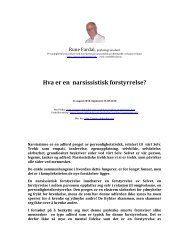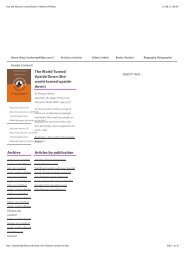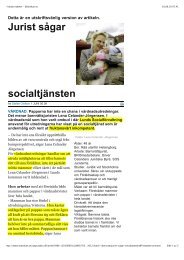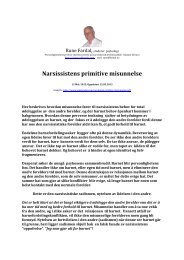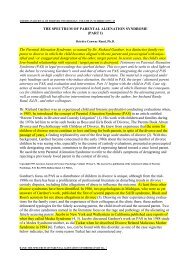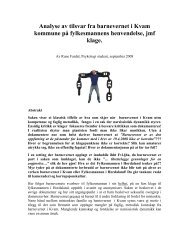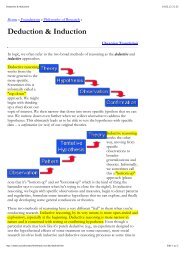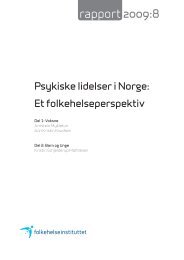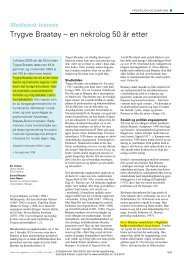The origins of narcissism and narcissistic personality disorder a
The origins of narcissism and narcissistic personality disorder a
The origins of narcissism and narcissistic personality disorder a
Create successful ePaper yourself
Turn your PDF publications into a flip-book with our unique Google optimized e-Paper software.
74 JOHN S. AUERBACH<br />
diminish the importance <strong>of</strong> others. More pragmatically, the self-effacing<br />
bias is <strong>narcissistic</strong> because, in its diminution <strong>of</strong> the self, it is no<br />
more accurate an account <strong>of</strong> the interpersonal world than is the bias<br />
for self-enhancement.<br />
Narcissism <strong>and</strong> self <strong>disorder</strong>s. <strong>The</strong> second practical reason for<br />
continuing to employ Freud’s paradoxical concept is that nowadays<br />
clinicians see themselves as treating patients whose problems are not<br />
the classical symptom neuroses (e.g., obsessionality or hysteria) but<br />
instead disturbances in self-esteem, identity, <strong>and</strong> object relations. <strong>The</strong>se<br />
are precisely the aspects <strong>of</strong> <strong>personality</strong> functioning that are implicated<br />
by the concept <strong>of</strong> <strong>narcissism</strong>, especially if <strong>narcissism</strong>, construed as a<br />
pathological phenomenon, is taken to refer not to objectlessness but<br />
to intense object relations in which the chosen object resembles the<br />
self (Freud, 1914/1957) or fills a selfobject need (Kohut, 1977). Although<br />
no epidemiological data support the contention that disturbances<br />
in the clinical population have shifted from transference neuroses<br />
to self <strong>disorder</strong>s or <strong>narcissistic</strong> neuroses, most clinicians would<br />
agree that such a change has occurred. This shift in clinical populations,<br />
if a reality, would explain the current popularity <strong>of</strong> theorists like Kernberg<br />
<strong>and</strong> Kohut. However, even if recent developments in clinical emphasis<br />
reflect a change not in the actual patients treated but only in<br />
the way psychotherapists have come to underst<strong>and</strong> themselves <strong>and</strong><br />
others, this transformation <strong>of</strong> outlook within a pr<strong>of</strong>ession with considerable<br />
influence on societal definitions <strong>of</strong> normality <strong>and</strong> abnormality<br />
still suggests that concerns about a culture <strong>of</strong> <strong>narcissism</strong> (Lasch, 1979)<br />
are well founded indeed.<br />
Recent Attempts to Reformulate the Concept <strong>of</strong> Narcissism<br />
Although the concept <strong>of</strong> <strong>narcissism</strong> is essential to underst<strong>and</strong> disturbances<br />
in self-esteem, identity, <strong>and</strong> object relations-disturbances generally<br />
grouped under the rubric <strong>of</strong> self <strong>disorder</strong>s, <strong>narcissistic</strong> <strong>disorder</strong>s,<br />
or borderline <strong>disorder</strong>s-the link between normal <strong>and</strong> pathological <strong>narcissism</strong><br />
needs to be made clear. Nowadays, theorists trying to avoid<br />
the pitfalls <strong>of</strong> the economic definition <strong>of</strong> <strong>narcissism</strong> as the libidinal<br />
investment in the self <strong>of</strong>ten regard <strong>narcissism</strong> as part <strong>of</strong> self-esteem<br />
regulation-specifically, as the maintenance <strong>of</strong> positive self-esteem<br />
(e.g., Dare & Holder, 1981; Stolorow, 1975). Such definitions constitute<br />
a distinct advance over the traditional conceptualization because they




